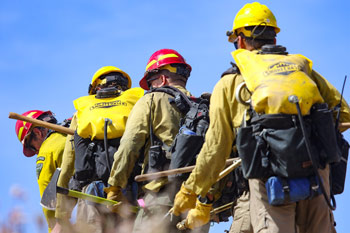Click Here for California Fires
August 3, 2024 - At this time, 89 large active wildfires are being managed with full suppression strategies nationwide. Current fires have burned 2,139,502 acres  nationwide. More than 30,600 wildland firefighters and support personnel are assigned to wildfires, including 24 complex and 5 Type 1 incident management teams, 676 crews, 1,829 engines, 184 helicopters, and six Modular Airborne Fire Fighting Systems, or MAFFS.
nationwide. More than 30,600 wildland firefighters and support personnel are assigned to wildfires, including 24 complex and 5 Type 1 incident management teams, 676 crews, 1,829 engines, 184 helicopters, and six Modular Airborne Fire Fighting Systems, or MAFFS.
Evacuation orders are in effect on 22 wildfires. If you live in an area that has been evacuated, please follow the instructions from local authorities. They will provide the latest recommendations based on the threat to your community and appropriate safety measures. If you are concerned about the potential for evacuation or other disaster impacts, ready.gov can help you get plans in place.
On August 1, predictive services staff at the National Interagency Coordination Center released the National Significant Wildland Fire Potential Outlook for August through November. For additional information about the current outlook visit the Outlook page on the NICC site.
A new fuels and fire behavior advisory has been issued for Colorado's Front Range and Eastern Wyoming. There are already advisories in place for Southwest Oregon, the region east of the Cascades in Oregon and Washington, Nevada, Southern Idaho, Utah, and California. Residents, travelers, or workers on their way to any of these states should be advised and familiarize themselves with the elevated risks.
Our greatest shared resource is the air that we breathe, and as we have had many occasions to observe in recent years, smoke impacts can even affect communities hundreds and hundreds of miles away from active wildfires. Fire.airnow.gov is an excellent resource for monitoring air quality in your area and understanding where smoke impacts may be coming from. Limit your exposure to poor air quality by paying attention to what times of day it is at its worst and avoiding strenuous activity and limiting your outdoor time during those windows.
Isolated to scattered mainly wet thunderstorms will shift north from northern California through the Cascades and Inland Northwest, Great Basin, and West Slope, but several dry strikes are likely outside rain cores. Well above normal temperatures will continue, but the heat and thunderstorm development will be offset by abundant cloud cover in some areas. Relative humidity will be higher, generally above 15% except across western and central Wyoming where single digits are expected. Isolated to scattered mixed wet and dry thunderstorms are likely to continue overnight through Idaho and western Montana. Somewhat drier air will shift into southern California, keeping thunderstorms isolated if any develop at all. Scattered wet thunderstorms are likely in the Southwest into the southern Great Basin and southern Colorado. Overall winds are expected to be light except near thunderstorms where outflows could reach 50 mph. A backdoor front will bring modest relief from heat to the central and southern Plains, with isolated to scattered thunderstorms from the central/southern High Plains to central Texas. Wet weather will be likely along much of the Gulf and East Coasts, while a tropical disturbance off the west coast of Florida will bring increasing showers and thunderstorms to the southern half of the peninsula. Drier conditions are forecast across Alaska today, while a few more showers are expected on the windward sides of Hawai’i as trade winds increase.
| Number of new large fires or emergency response * New fires are identified with an asterisk |
7 | States currently reporting large fires: |
| Total number of active large fires Total does not include individual fires within complexes. |
89 | |
| Acres from active fires | 2,139,502 | |
| Fires contained | 9 |
Year-to-date statistics
| 2024 (1/1/24-8/03/24) | Fires: 28,773 | Acres: 4,554,901 |
| 2023 (1/1/23-8/03/23) | Fires: 31,382 | Acres: 1,257,389 |
| 2022 (1/1/22-8/03/22) | Fires: 39,444 | Acres: 5,802,433 |
| 2021 (1/1/21-8/03/21) | Fires: 38,207 | Acres: 3,259,913 |
| 2020 (1/1/20-8/03/20) | Fires: 32,563 | Acres: 2,190,681 |
| 2019 (1/1/19-8/03/19) | Fires: 27,061 | Acres: 3,360,943 |
| 2018 (1/1/18-8/03/18) | Fires: 38,535 | Acres: 4,981,070 |
| 2017 (1/1/17-8/03/17) | Fires: 39,635 | Acres: 5,730,848 |
| 2016 (1/1/16-8/03/16) | Fires: 34,898 | Acres: 3,600,570 |
| 2015 (1/1/15-8/03/15) | Fires: 36,754 | Acres: 5,929,374 |
| 2014 (1/1/14-8/03/14) | Fires: 34,151 | Acres: 1,702,600 |
10-year average Year-to-Date
| 2014-2023 | Fires: 35,310 | Acres: 3,781,582 |
Source: NIFC








